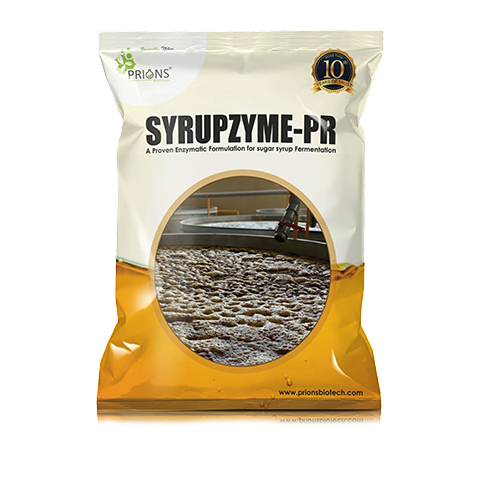Prions Biotech
Sugar Syrup Fermentation Enzyme (SYRUPZYME-PR)

Sugar Syrup Fermentation Enzyme (SYRUPZYME-PR)
(A Proven Enzymatic Formulation for sugar syrup Fermentation)Sugar syrup the most important and valuable product of the sugar-making process holds a key place in the energy security needs of the country. India is an Agri economy and even though the production of ethanol from grains is picking up, food security needs to put the onus of fuel ethanol production squarely on the back of sugar syrup processing. Sugar syrup can be hydrolyzed by enzymes and converted into simple sugar, which yeast can take further for alcohol conversion.
It is important to understand that starch is actually complex sugar. Each starch molecule is a long chain of up to a thousand glucose molecules bonded either in a straight line or branching like the leafless arm of the tree. Two enzymes are used to attack the tree of different types. Alpha amylase attacks the branch point and reduces the tree into individual segments, while the beta enzyme attacks the ends of each branch and nibbles individual glucose molecules.
SUGAR SYRUP FERMENTATION ENZYME DOSAGE
SYRUPZYME- PR is dosed at 3-5ppm/MT of wash or wortDivided doses have to be done at the pre-fermenter and fermenter stages to get the best results.
SUGAR SYRUP FERMENTATION ENZYME PRESENTATION
1 kg packing.Advantages of Sugar Syrup Fermentation Enzyme
- Increase in efficiency and alcohol yield by 5/10L MT of molasses
- The increased alcohol concentration in the mash and a reduction in spent wash quantity.
- High rate of yeast growth and metabolism
- Low residual sugar
- Prevention of bacterial contamination & reduction in the mash's volatile acidity
- Low bi-products in the mash
- High improved neutral spirit quality
- Reduction in the fermentation hold up
- Converting Unfermentable Sugars to Fermentable Sugar
- Strengthening the Yeast Cell Wall.
- Controlling Bacterial Contamination and Proliferation.
- A smooth and steady flow of slurry
- Prevents bad effects of yeast inhibitors
Benefits of Sugar Syrup Fermentation Enzyme
- Increases in efficiency lead to a proportionate increase in CO2 collection. Elimination of lactobacillus contamination. Elimination of biocides antibiotics.
- Reduction in yeast invigorates.
- Reduction in anti-foam agents.
- Reduction in scaling.
- Fermentation Efficiency increases by 2 -3%
- Reduction of volatile acidity
